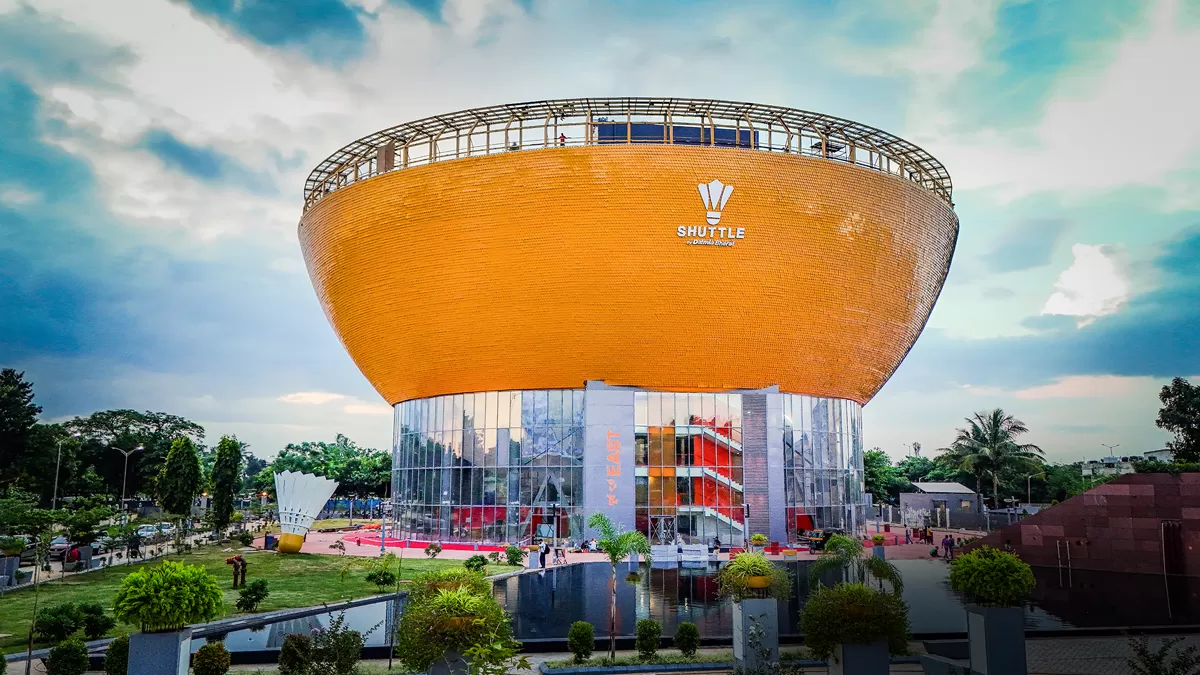Dalmia Bharat’s shuttlecock-shaped badminton centre in Bhubaneswar is a bold leap in sports infrastructure – symbolic in form, global in ambition and sustainable by design. A collaboration with the Odisha government and Gopichand Academy, it reflects India’s evolving sporting vision.
Building more than an academy
At the heart of ‘Shuttle by Dalmia Bharat’ lies a powerful vision, one that sees infrastructure not merely as physical structures but catalysts for national progress. “With this project, the intent was to build more than a badminton academy,” says Puneet Dalmia, Managing Director & CEO, Dalmia Bharat. “We aimed to create a place that inspires young athletes and redefines what sports infrastructure can look like in India.”
Rooted in the spirit of the game, the architecture is bold and purposeful – a natural extension of Dalmia Bharat’s belief that “India is ready to invest in world-class design for world-class performance.”
A unified mission
The academy is the result of a seamless partnership between Dalmia Bharat, the Odisha government and the Gopichand Academy. As Dalmia notes, “It wasn’t just a collaboration; it was a unified mission from the start.” The Odisha government brought its commitment to sports while Pullela Gopichand contributed technical expertise and long-term vision.
For its part, Dalmia Bharat brought in engineering and project execution capabilities to realise the architectural ambition. In addition to elite sports training, the facility includes spaces dedicated to yoga and meditation, reflecting what Dalmia calls “a holistic approach that strengthens physical fitness, mental toughness and inner calmness”.
A statement of sporting intent
With an expansive 77,000 sq ft of built-up area, the academy will train 50 players annually and attract national and international tournaments. “Until now, very few training centres in India have combined global-standard functionality with iconic design,” points out Dalmia. “This facility does both.”
The message is clear: “This is infrastructure that inspires. It shows what's possible when sport is treated as a national priority, not an afterthought.”
From symbol to structure
The striking form of the building – a giant shuttlecock – was not an aesthetic afterthought but the starting point of the design. “We wanted a form that clearly connected to the sport,” explains Sourabh Gupta, Principal Architect, Studio Archohm. “The shuttlecock was a natural choice. But turning that into a functioning building was a journey.”
The goal was to translate the movement, balance and symmetry of badminton into architectural form. What began as a symbolic idea evolved into a space where design and function work seamlessly together.
Where performance meets aesthetics
Internally, the building is calibrated to meet global standards in lighting, ventilation and court dimensions. “To retain visual lightness without compromising performance, we created a suspended court box wrapped within the larger shell,” shares Gupta. “The building literally breathes between two skins – one functional, one visual.”
This dual-layer structure ensures optimal playing conditions while delivering a striking profile that commands attention.
Designing against the wind
One of the most complex challenges was building a lightweight, expressive form that could also withstand Odisha’s frequent cyclones. “Crafting the shuttlecock silhouette with aerodynamic integrity required precise modelling and high-level structural innovation,” says Dalmia.
Gupta elaborates, “The circular form is inherently aerodynamic, which helps reduce wind loads. The structure sits atop a reinforced glass cylinder and internal load paths were meticulously planned to disperse forces efficiently.” Every material and system was chosen not just for its aesthetic appeal, but for resilience.
Illuminating the night
Come dusk and another facet of the building comes to light – literally. “Lighting was conceived as an integral part of the experience,” Gupta explains. By night, each feather of the shuttlecock is lit independently, allowing the entire structure to glow. What functions as a high-performance sports centre during the day becomes a luminous public landmark at night.
Sustainability by design
Sustainability was embedded into the project at every level. “From using low-carbon materials to optimising energy loads, we ensured to keep the building’s environmental footprint minimal,” says Gupta.
The shuttlecock’s inverted form also supports passive cooling. “It allows warm air to rise and exit through planned vents, keeping interiors cooler naturally,” he adds. The circular footprint reduces direct sun exposure while the roof design provides shade throughout the day, dramatically reducing reliance on mechanical cooling systems.
In line with Dalmia Bharat’s sustainability commitment, green construction principles were rigorously applied. “We prioritised locally sourced, low-carbon materials, including fly-ash concrete and green-certified finishes,” notes Gupta.
Rainwater harvesting, wastewater recycling and soft landscaping for groundwater recharge were built into the infrastructure. Even construction waste was managed through strict segregation and reuse.
A place for everyone
While designed as a high-performance training facility, the academy has also been envisioned as a social and civic space. “The intention was to create a community space, not just a sports facility,” says Gupta.
Indeed, features like the walk of fame, an outdoor amphitheatre and shaded public areas make the campus inclusive and engaging. “The green zones weren’t just aesthetic choices,” he underlines. “They were created to support microclimates, social activity and biodiversity.”
-Kavita Parab
FACT FILE
Project name: Shuttle by Dalmia BharatLocation: Kalinga Stadium, Bhubaneswar, OdishaConstruction cost: Significant CSR-funded investment by Dalmia Bharat (exact amount confidential)Year of completion: December 12, 2024Total area: 77,000 sq ft built-up area on a 3-acre siteDeveloper: Dalmia Bharat GroupArchitect: ArchohmTechnologies suppliers: Integrated systems for HVAC, lighting, energy-efficiencyOther vendors/suppliers: Lighting designers, landscape consultants, structural engineer



















